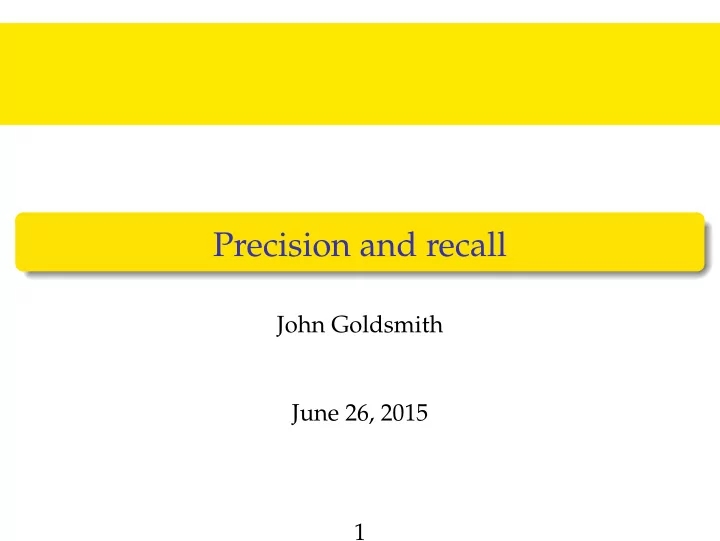

Precision and recall John Goldsmith June 26, 2015 1
Document retrieval Precision How well do the documents that your system gives you actually satisfy what you are looking for? Recall How sure are you that you got back all of the documents you really wanted? 2
Document retrieval Precision #( appropriate documents returned ) #( documents returned ) Recall #( appropriate documents returned ) #( appropriate documents ) 3
Precision and recall These terms have become the standard expectation of how a method is evaluated. Precision and recall trade-off 4
Precision and recall trade-off You can always get 100% precision, and you can always get 100% recall, but the cost is almost always too great, in both cases. One solution: use the F-score: the reciprocal of the average of the reciprocals. 2 × precision × recall precision + recall . 1 1 ab ) = 2 ab b ) = 2 ( 1 1 a + 1 1 2 ( a + b a + b 5
Precision and recall trade-off Or you can give a chart of various precision/recall trade-offs produced by adjusting parameters of the algorithm. 6
Precision and recall Gold standard: Yes No Test says yes: True positives False positives Precision Test says no: True negatives False negatives Recall 7
More than one possible test: 1 Task: Find morphemes Your algorithm wants to find morphemes (=word parts): anti-alias-ing Measurement: find breaks One way to measure this is by predicting which positions mark breaks: Gold standard truth is 0,4,9,14. Then antialias-ing is 0,9,14. Precision is 3 4 and recall is 3 4 . 8
Baseline Baseline What is the precision and recall of a clever but useless algorithm: e.g., mark morphemes boundaries before the first and after the last letter? Baseline A clever but useless algorithm defines our baseline . Hopefully we have nowhere to go than up from there (though that is not guaranteed!). 9
Possible test 2: Discover a list of morphemes Suppose our goal is to “pullout” the morphemes of the language. Then if ed or ing is found in any word, that counts as 1 true positive. If the algorithm cuts: jump-ed walk-ed mov-e-d lov-ed raise-d and the gold standard says jump walk move love raise ed , then there are 4 true positives (jump, walk, raise, ed) and 2 false negatives (move, love) (because they were not found by the algorithm), and 3 false positives (e,d, lov)(because they were found but they should not have been found). Precision: 4 out of (4 + 3) = 0.571; recall is 4 out of (4 + 2) = 0.667. 10
11
Recommend
More recommend